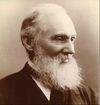1990: Magnetoresistive read-head HDD introduced
MR, GMR & TMR heads deliver successive increases in storage density




In 1856, William Thomson (Lord Kelvin) discovered the phenomenon of anisotropic magnetoresistance (AMR) in which a changing magnetic field induces a resistance change in a conductor. Based on a proposal by R. P. Hunt of Ampex, IBM produced the Model 3660/3663 Point-of-Sale system with an AMR magnetic stripe reader in 1975. As the readback signal from an MR head can be much larger than that from an inductive head of the same size, in 1984 IBM introduced the Model 3480 magnetic tape storage unit with an MR read element added alongside an inductive write element to form a merged read/write head. IBM San Jose adapted the technology for a hard disk drive unit code named “Sawmill” that shipped in the IBM 9345 DASD system in 1990. Sawmill had an areal density of 107 Mbits/sq. inch. In 1991, head and disk improvements in the IBM Corsair HDD raised the number to 132 Mbits/sq. inch. Corsair heads and disks were slightly improved versions of Sawmill components. In 1994, Fujitsu, Hitachi, and Hewlett Packard independently developed MR heads. HP licensed the technology to Dastek (later Headway-TDK) for merchant market sale.
Giant magnetoresistance, discovered by Albert Fert and Peter Grunberg in 1988 (recognized by the Nobel Prize in Physics in 2007), relies on alternating layers of atomically thin magnetic and non-magnetic conductive materials. The Information Storage Industry Consortium (INSIC) led a research program on GMR heads and in 1997 IBM introduced the “spin-valve” GMR head with an areal density of 1 Gbit /sq. inch in a 16.8 GB drive for the Deskstar 16GP personal computer. John Slonczewski proposed in 1974 that magnetic tunnel junctions could be used as a “Magnetic Gate.” Tunneling magnetoresistance (TMR) involves electrons moving through an insulating barrier between magnetic layers resulting in a relatively large resistance change between the parallel and anti parallel orientations of magnetization. TMR heads achieving an areal density of 84 Gbits/sq. were introduced in 2004 in the Seagate Momentus II, 2.5-inch, 120 GB HDD. Manufactured with thin-film technology, these three generations of MR heads in combination with PMR disks substantially contributed to the achievement of an areal density of 1 terabit/sq. in. by 2014.
Contemporary Documents
- Bajorek, C. H., C, Coker, L. T. Romankiw and D. A. Thompson. “Hand-held Magnetoresistive Transducer” IBM J. Res. Dev. (Vol: 18, No. 6, 1974) p.541
- Bajorek, C. H., L. T. Romankiw and D. A. Thompson. “Self Biased Magnetoreistive Sensor” U.S. Patent 3,840,898 (1974)
- Bajorek, C. H., S. Krongelb, L. Romankiw and D. Thompson. “A Permalloy Current Sensor” IEEE Trans. Mag. (Vol: 12, No. 6, 1976). p. 813
- Bajorek, C. H., S. Krongelb, L. T. Romankiw and D. A. Thompson. “An Integrated Magnetoresistive Read, Inductive Write High Density Recording Head” AIP Conf. Proc. (Vol: 24, 1975) p. 548
- Beaulieu T. J. and D. A. Nepela. “Induced Bias Magnetoresistive Read Transducer” U.S. Patent 3,864,751 (1975)
- Cannon, D. M., et. al. “Design and Performance of a Magnetic Head for a High Density Tape Drive” IBM J. Res. Dev. (Vol: 30, No. 3, 1986) p. 270
- Dieny, B., et. al. “Magnetoresisitive Sensor Based on the Spin Valve Effect” U.S. Patent 5,206,590 (1993)
- Gurney, B., M. Carey, C. Tsang, M. Willams “Spin Valve Giant Magnetoresistive Sensors for Recording Head Applications” Sixth International Symposium on Magnetic Materials, Processes and Devices (October 23, 2000) (Retrieved on 4.29.15 from: http://www.electrochem.org/dl/ma/198/pdfs/0593.pdf)
- Heim, D. E., R. E. Fontana, V. S. Speriousu, B. A. Gurney and M. L. Williams. “Design and Operation of Spin Valve Sensors” IEEE Trans. Mag (Vol: 30, No. 2, 1994) p. 316
- Hunt, R.P.. “A Magnetoresistive Readout Transducer” IEEE Trans. Mag. (Vol: 7, 150, 1971);
- Julliere, M. “Tunneling Between Ferromagnetic Films” Phys. Let. (Vol: 54A, No. 3, 1975) p. 225
- Kanai, Hitoshi et. al. “Advanced Spin-Valve GMR Head” Fujitsu Sci. Tech. J. (Vol: 37 No: 2, December 2001) Pp. 174 -182 (Retrieved on 5.2.15 from: www.fujitsu.com/downloads/MAG/vol37-2/paper08.pdf)
- Slonczewski, John. “Magnetic Bubble Tunnel Detector” IBM Technical Disclosure Bulletin (Vol. 19, No. 6, Nov. 1976) pp. 2328-2330
- Thompson, D. A.,“Three-Legged Magnetic Recording Head Using a Magnetoresistive Element” U.S. Patent 3,921,217 (1975)
- Sining Mao et al, “Commercial TMR Heads for Hard Disk Drives: Characterization and Extendibility at 300 Gbit/in2” IEE Trans Mag. (Vol: 42, No. 2, 2006). p. 97
More Information
- Bajorek, Christopher H. “Magnetoresistive Heads, 1990” CHM Storage SIG Research Notes (November 2014)
- Scranton, R. “IBM Deskstar 16GP (14GXP)” CHM Storage SIG Research Notes (June 2012)
- “The Giant Magnetoresistive Head: A giant leap for IBM Research” IBM Research (undated) (Retrieved on 6.13.15 from: http://www.research.ibm.com/research/gmr.html)
- Belleson, Jim & Ed Grochowski. “The era of giant magnetoresistive heads” (Retrieved on 4.28.15 from: http://www2.hgst.com/hdd/technolo/gmr/gmr.htm)
- Gurney, Bruce A. “Giant Magnetoresistance in Magnetic Recording” AAPPS Bulletin (Vol. 18, No. 6, December 2008) pp. 18-23
- Plumer, Martin L., et. al. “New paradigms in Magnetic Recording” “New paradigms in Magnetic Recording” La Physique du Canada (Vol: 67 No: 1, 2011) pp. 25 – 29
- Wang, Shan X., Alexander M. Tarartorin. “Magnetoresistive Heads” Magnetic Information Storage Technology, Academic Press (1990) pp. 123 - 176
Oral Histories
- “Advanced ferrite disk heads oral history panel” Computer History Museum Oral History # 102657927 (2005-11-03)
- “Harker, Jack (John M.) oral history with C. Denis Mee” Computer History Museum Oral History # 102658172 (2007-05-30)
- “Advanced thin film disk heads oral history panel” Computer History Museum Oral History # 102657929 (2005-11-11)
- “Chen, Tu oral history” Computer History Museum Oral History # 102657958 (2005-10-28)
- "Dill, Frederick (Rick) H. oral history" Computer History Museum Oral History # 102737911 (2015-06-11)
- "Slonczewski, John oral history" Computer History Museum Oral History # 102738241 (2017-04-12)
- "TMR Head oral history panel" Computer History Museum Oral History # 102717212 (2016-08-03)
1990_MR_v9
Rev: 2.5.18


